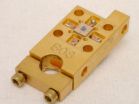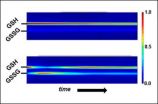(Press-News.org) It's not quite Star Trek communications—yet. But long-distance communications in space may be easier now that researchers at the National Institute of Standards and Technology (NIST) and Jet Propulsion Laboratory (JPL) have designed a clever detector array that can extract more information than usual from single particles of light.
Described in a new paper,* the NIST/JPL array-on-a-chip easily identifies the position of the exact detector in a multi-detector system that absorbs an incoming infrared light particle, or photon. That's the norm for digital photography cameras, of course, but a significant improvement in these astonishingly sensitive detectors that can register a single photon. The new device also records the signal timing, as these particular single-photon detectors have always done.
The technology could be useful in optical communications in space. Lasers can transmit only very low light levels across vast distances, so signals need to contain as much information as possible.
One solution is "pulse position modulation" in which a photon is transmitted at different times and positions to encode more than the usual one bit of information. If a light source transmitted photons slightly to the left/right and up/down, for instance, then the new NIST/JPL detector array circuit could decipher the two bits of information encoded in the spatial position of the photon. Additional bits of information could be encoded by using the arrival time of the photon.
The same NIST/JPL collaboration recently produced detector arrays for the first demonstration of two-way laser communications outside Earth's orbit using the timing version of pulse position modulation.** The new NIST/JPL paper shows how to make an even larger array of detectors for future communications systems.
The new technology uses superconducting nanowire single-photon detectors. The current design can count tens of millions of photons per second but the researchers say it could be scaled up to a system capable of counting of nearly a billion photons per second with low dark (false) counts. The key innovation enabling the latest device was NIST's 2011 introduction of a new detector material, tungsten-silicide, which boosted efficiency, the ability to generate an electrical signal for each arriving photon.*** Detector efficiency now exceeds 90 percent. Other materials are less efficient and would be more difficult to incorporate into complex circuits.
The detectors superconduct at cryogenic temperatures (about minus 270 °C or minus 454 °F), and cooling needs set a limit on wiring complexity. The NIST/JPL scheme requires only twice as many wires (2N) as the number of detectors on one side of a square array (N x N), greatly reducing cooling loads compared to a one-wire-per-detector approach while maintaining high timing accuracy. NIST researchers demonstrated the scheme for a four-detector array with four wires and are now working on a 64-detector array with 16 wires.
In the circuit, each detector is located in a specific column and row of the square array. Each detector acts like an electrical switch. When the detector is in the superconducting state, the switch is closed and the current is equally distributed among all detectors in that column. When a detector absorbs a photon, the switch opens, temporarily diverting the current to an amplifier for the affected column while reducing the signal through the affected row. As a result, the circuit generates a voltage spike in the column readout and a voltage dip in the row readout. The active detector is at the intersection of the active column and row.
INFORMATION:
The research was supported by the Defense Advanced Research Projects Agency.
V.B. Verma, R. Horansky, F. Marsili, J.A. Stern, M.D. Shaw, A.E. Lita, R.P. Mirin and S.W. Nam. A four-pixel single-photon pulse position camera fabricated from WSi superconducting nanowire single photon detectors. Applied Physics Letters 104, 051115. DOI: 10.1063/1.4864075. Posted online Feb. 4, 2014.
See Oct. 28, 2013, National Aeronautics and Space Administration news release, "Historic Demonstration Proves Laser Communication Possible," at http://www.nasa.gov/content/goddard/historic-demonstration-proves-laser-communication-possible/#.Um62W3Dkvv2.
See 2011 NIST Tech Beat article, "Key Ingredient: Change in Material Boosts Prospects of Ultrafast Single-photon
Detector," at http://www.nist.gov/pml/div686/detector-063011.cfm.
Clever NIST/JPL technology decodes more information from single photons
2014-02-12
ELSE PRESS RELEASES FROM THIS DATE:
New NIST method evaluates response to oxidation in live cells
2014-02-12
Researchers at the National Institute of Standards and Technology (NIST) have developed a new method for accurately measuring a key process governing a wide variety of cellular functions that may become the basis for a "health checkup" for living cells.
The NIST technique measures changes in a living cell's internal redox (reduction-oxidation) potential, a chemistry concept that expresses the favorability of reactions in which molecules or atoms either gain or lose electrons. Redox reactions are important to cell chemistry because they regulate many genes and the proteins ...
Popular disinfectants do not kill HPV
2014-02-12
Commonly used disinfectants do not kill human papillomavirus (HPV) that makes possible non-sexual transmission of the virus, thus creating a need for hospital policy changes, according to researchers from Penn State College of Medicine and Brigham Young University.
"Because it is difficult to produce infectious HPV particles for research, little has been known about HPV susceptibility to disinfection," said Craig Meyers, Distinguished Professor of Microbiology and Immunology, Penn State College of Medicine.
Use of disinfectants on HPV in health care settings has been ...
Hollywood failing to keep up with rapidly increasing diversity, UCLA study warns
2014-02-12
When it comes to influential positions in the entertainment industry, minorities and women are represented at rates far below what would be expected given their percentage of the general population, according to a new study done at UCLA's Ralph J. Bunche Center for African American Studies.
In fact, the report shows, the proportion of female and minority actors, writers, directors and producers in films and TV ranges from just one-twelfth to one-half of their actual population percentage.
"The report paints a picture of an industry that is woefully out of ...
Meeting the eye-witnesses of ocean change
2014-02-12
Members of the German research network BIOACID (Biological Impacts of Ocean Acidification) are developing a model that links ecosystem changes triggered by ocean acidification and climate change with their economic and societal consequences. Workshops and interviews with stakeholders from the Norwegian fishing industry and tourism sector, the government and environmental organisations help them to identify key aspects for their assessment.
During the past ten years, scientists have learned a lot about the effects of ocean acidification on marine ecosystems. It has become ...
Cities support more native biodiversity than previously thought
2014-02-12
(Santa Barbara, Calif.) — The rapid conversion of natural lands to cement-dominated urban centers is causing great losses in biodiversity. Yet, according to a new study involving 147 cities worldwide, surprisingly high numbers of plant and animal species persist and even flourish in urban environments — to the tune of hundreds of bird species and thousands of plant species in a single city.
Contrary to conventional wisdom that cities are a wasteland for biodiversity, the study found that while a few species — such as pigeons and annual meadow grass — are shared across ...
4 years on, ICU Patients with kidney injury show high mortality & elevated urinary protein
2014-02-12
In 4 years of follow up of 1464 participants in the randomized controlled trial Randomised Evaluation of Normal vs. Augmented Levels of RRT (RENAL) study, Martin Gallagher (The George Institute for Global Health, Sydney, Australia) and colleagues found that patients with acute kidney injury (AKI) in an intensive care unit (ICU) who require renal replacement therapy (RRT; hemodialysis combined with hemofiltration) do not benefit from higher intensity RRT. At a median of 43.9 months follow up, mortality (63% in the low intensity and 63% in the high intensity group), as well ...
Study challenges a close link between recent weight gain and diabetes
2014-02-12
It is a common notion that type 2 diabetes is precipitated by substantial progressive weight gain, but a study published this week in PLOS Medicine suggests that this might not be true.
Dorte Vistisen and Kristine Færch, from the Steno Diabetes Center in Gentofte, Denmark, and colleagues analyzed data from participants of the Whitehall II cohort, a group of London-based civil servants who have been followed for more than a decade, to see what changes in body weight and other parameters had occurred in people in the years before they were diagnosed with diabetes.
6,705 ...
What makes memories last?
2014-02-12
Prions can be notoriously destructive, spurring proteins to misfold and interfere with cellular function as they spread without control. New research, publishingin the open access journal PLOS Biology on February 11 2014, from scientists at the Stowers Institute for Medical Research reveals that certain prion-like proteins, however, can be precisely controlled so that they are generated only in a specific time and place. These prion-like proteins are not involved in disease processes; rather, they are essential for creating and maintaining long-term memories.
"This protein ...
Fifty-five genes linked to a powerful tumor suppressor predict breast cancer survival
2014-02-12
WASHINGTON — A panel of 55 genes, almost all of which are impacted by the loss of a particular protein, appears to predict if breast cancer will become invasive, leading to poorer survival, researchers at Georgetown Lombardi Comprehensive Cancer Center report in PLOS ONE.
The panel represents loss of a powerful tumor suppressor gene, SYK, as well as genetic alterations in 51 other genes that are directly affected by the loss of a copy of the SYK gene and the absence of its protein.
"Without SYK, the protein it makes, and genetic disruption in a set of genes thought ...
Kidney failure risk for organ donors 'extremely low'
2014-02-12
The risk of a kidney donor developing kidney failure in the remaining organ is much lower than in the population at large, even when compared with people who have two kidneys, according to results of new Johns Hopkins research.
The results, published in the Feb. 12 issue of the Journal of the American Medical Association, describes what is believed to be the largest study ever conducted of kidney disease risk in living kidney donors, encompassing all such donors in the United States over a 17-year period. The same researchers reporting in the same journal also showed ...


